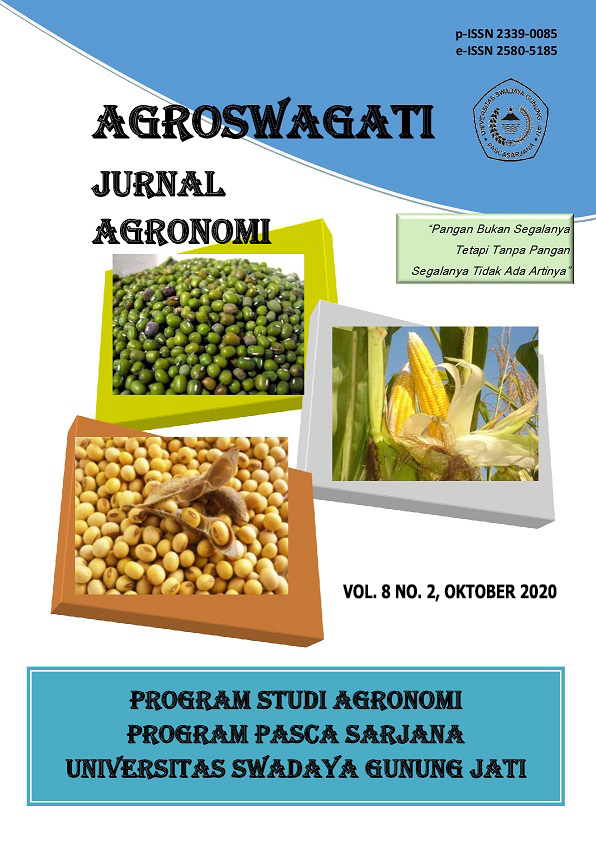PENGARUH PEMUPUKAN NPK MAJEMUK DAN UREA TERHADAP PERTUMBUHAN DAN HASIL PADI GOGO
DOI:
https://doi.org/10.33603/agroswagati.v8i2.4947Kata Kunci:
NPK, Urea, growth, yield, Upland riceAbstrak
Research on improving fertilization technology of upland rice is still being developed. This research aimed to examine the most efficient technology fertilization (NPK and Urea) to increase the productivity of upland rice. Research had been conducted in upland rice fields, located at Ploso Kerep, Indramayu District, in MT I 2012/2013 designed in split plot with three replications. The main plot was the level of NPK fertilizer, consisting of (A) Without NPK (0 kg / ha), (B) NPK 100 kg / ha, (C) NPK 200 kg / ha, and (D) NPK 300 kg / Ha, and as subplots are (1) Without Urea 0 kg / ha, (2) Urea 100 kg / ha, (3) Urea 200 kg / ha and (4) Urea 300 kg / ha. The results showed that NPK and Urea can improve growth and yield of upland rice. NPK fertilizer with 300 kg / ha has produced the highest number of panicles per hill (12.07 grain panicles), while at Urea 200 kg / ha resulted in the highest panicle number of 11.54 grain panicles. The highest dry grain yield (5.78 t / ha) was obtained at NPK 300 kg / ha with an average increase of 100 kg / ha NPK reaching 370 kg / ha. The combination of NPK 300 kg / ha and with 300 kg urea / ha, the weight of 1000 urea 300 kg / ha can be increased to 7.58% when compared without fertilizing.
Referensi
Amir, M. dan M.K. Kardin. 1995. Pengendalian penyakit jamur. p. 825-843. In Soenarjo et al. Padi, Buku 3. Badan Penelitian dan Pengembangan Pertanian. Puslitbangtan. Bogor.
Arraudeau, M.A., B.S. Vergara. 1992. Pedoman Budidaya Padi Gogo. Balai Penelitian Tanaman Pangan Sukarami. Badan Penelitian dan Pengembangan Pertanian.
Badan Pusat Statistik, 2016. Statistik Indonesia. https://www.bps.go.id
Badan Penelitian dan Pengembangan Pertanian. 2016. Deskripsi Varietas Unggul Padi. Balitbangtan Kementerian Pertanian.
Cabuslay, G.S., B.S. Vergara, and R.U. Quintana. 1995. Low light stress, mechanism of tolerance and screening method. Philippines J. Crop. Sci.16 (1): 39.
Fairhurst, T., C. Witt, R. Buresh dan A. Dobermann. 2007. Padi: Panduan Praktis Pengelolaan Hara. International Rice research Institute (IRRI).
Notohadiprawiro, T., S. Soekodarmodjo dan E Sukana. 2006 Pengelolaan Kesuburran tanah dan peningkatan efisiensi pemupukan. Ilmu tanah Univerrsitas Gajah Mada p4.
Partohardjono, S., J. S. Adiningsih, dan I. G. Ismail. 1990. Peningkatan produktivitas lahan kering beriklim basah melalui teknologi sistem usahatani. p. 47-62. di Syam, M. Risalah Lokakarya Penelitian Sistem Usahatani, Sistem Usahatani di Lima Agroekosistem. Pusat Penelitian dan Pengembangan Tanaman Pangan, Badan Litbang Pertanian.
Sarwono, J. 2017. http://www.jonathansarwono.info/korelasi/korelasi.htm
Sholeh. 1975. Penyerapan unsur hara P pada tingkat-tingkat pertumbuhan tanaman padi sawah. Tesis sarjana FP JIT UGM
Suyamto, H.M. Toha, Suwarno, M.Y. Samaullah, A. Guswara, T. S. Kadir. 2008. Pengelolaan Tanaman Terpadu (PTT) Padi Gogo. Badan Penelitian dan Pengembangan Pertanian, Departemen Pertanian
Tim Peneliti Badan Litbang Pertanian. 1998. Laporan Hasil Penelitian Optimalisasi Pemanfaatan sumber DayaAlam dan Teknologi untuk Pengembangan Sektor Pertanian dalam Pelita VII. Pusat Penelitian Tanah dan Agroklimat. 386 hal.
Toha, H M, Prayitno, I Yuliardi dan K Permadi. 2005. Penelitian dan pengkajian model pengembangan pengelolaan tanaman dan sumberdaya terpadu (PTT) padi gogo. Laporan tahunan 2004. Balai Penelitian Tanaman Padi, 25 hal.
Toha, H M. 2007. Peningkatan produktivitas padi gogo melalui penerapan pengelolaan tanaman terpadu dengan introduksi varietas unggul. Penelitian Pertanian, Pusat Penelitian dan Pengembangan Tanaman Pangan, Badan Litbang Pertanian. No. 26 (3): 180-187.
Unduhan
Diterbitkan
Terbitan
Bagian
Lisensi
The Authors submitting a manuscript do so on the understanding that if accepted for publication, copyright of the article shall be assigned to Jurnal AGROSWAGATI, Sekolah Pascasarjana Ilmu Pertanian. Universitas Swadaya Gunung Jati as publisher of the journal. Copyright encompasses rights to reproduce and deliver the article in all form and media, including reprints, photographs, microfilms, and any other similar reproductions, as well as translations.
Jurnal AGROSWAGATI, Universitas Swadaya Gunung Jati and the Editors make every effort to ensure that no wrong or misleading data, opinions or statements be published in the journal. In any way, the contents of the articles and advertisements published in Jurnal AGROSWAGATIare the sole responsibility of their respective authors and advertisers.

